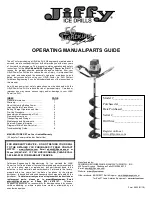
Trident Emergency Products, LLC
2940 Turnpike Drive | Suite #9 | Hatboro, PA 19040 USA
14
AirPrime
™ Fire Pump Priming System
™
Annual Primer Testing
The AirPrime™ primer is designed to meet the NFPA requirements of:
Dry Vacuum (
TEST #1
)
and
Priming Time (
TEST #2
)
. These tests
should be performed on an annual basis, or whenever major repairs or modifications have been made to the fire pump, plumbing or primer.
TEST #1
Dry Vacuum Test
: Checks the primer’s ability to produce 22 inches (Hg)
[.745 Bar]
of vacuum, and the pump and plumbing’s
ability to hold that vacuum. The test may be run with the pump in gear or not engaged. Never run a dry pump at engine speeds above
1200 RPM. There is no time requirement for the vacuum to reach 22 inches. If the compressor has a capacity of 13.2 CFM
[374 cu. cm.
displacement]
, it can take several minutes to reach 22 inches
[.75 Bar]
. This time can be shortened by not engaging the pump and increasing
the engine speed to 1200 RPM. The test process is as follows:
1. Drain all water from pump and plumbing.
2. Close all valves and drains. Cap all suction openings and the outlet off of the suction side relief valve (if so equipped).
3. Connect a test vacuum gauge to the intake test gauge connection on the pump panel.
4. Operate the AirPrime with the air system at over 100 PSIG
[7.0 Bar]
pressure, air tanks filled to capacity, and at 1000 RPM engine
speed; until the vacuum gauge indicates 22 inches (Hg)
[.75 Bar]
or more of vacuum. (If the primer is an
Automatic
AirPrime, use the
PRIME
mode switch position to engage the primer).
5. Watch the gauge, if the vacuum falls more than 10 inches in 5 minutes the test has failed and is a certain indication of an air leak(s).
Vacuum leaks may be detected by ear, with the engine turned off. Correct leaks immediately and test the priming system again.
TEST #2
Priming Time Test
: This test is to prove that the fire pump and primer has the capability of attain a prime and creating
discharge water pressure in a set period of time. This test is also conducted by the apparatus builder prior to delivery. The fire pump shall
be engaged and primer actuated. The test is part of an annual pump performance test and is performed as follows:
1. Set up the apparatus in accordance with the pumping test outlined in the NFPA standards.
2. Engage the pump, and increase the throttle to a maximum engine speed of 1000 RPM.
3. Operate the AirPrime with the air system at over 100 PSIG
[7.0 Bar]
pressure, air tanks filled to capacity, and at 1000 RPM engine
speed.
• For the Manual controlled primer, release the push button when a discharge pressure over 20 PSIG
[1.4 Bar]
is obtained.
• For the
Automatic
AirPrime, place the switch in the
AUTO
position, it will turn the primer off automatically when priming is attained.
4. The time to prime should not exceed 30 seconds for 1250 GPM
[4700 LPM]
and smaller pumps. The time to prime should not exceed
45 seconds for 1500 GPM
[5600 LPM]
and larger pumps. An additional 15 seconds is allowed for pumps with auxiliary suctions using
4" or larger piping.
Higher lifts and operating at higher elevations will slow down time to prime. The air compressor rating should be a minimum of 18 CFM
[410 cu. cm. displacement]
for elevations over 4000 feet
[1200 m]
and lifts in excess of 15 feet
[4.5 m]
. Operation at these extremes may
require the primer to be operated at engine speeds in excess of 1000 RPM without engaging the pump, until water reaches the impeller.
Never run a dry pump at engine speeds above 1200 RPM.
IN-SERVICE OPERATIONAL TEST
(Ramp Test)
The integrity and operation can be quickly checked (on a daily or weekly basis) as outlined below, without fire pump engagement:
1. Drain all water from pump and plumbing.
2. Close all valves and drains. Cap all suction openings.
• Operate the AirPrime with the air system at over 100 PSIG
[7.0 Bar]
pressure, air tanks filled to capacity, and the engine running at
1000 RPM (with an Automatic AirPrime electrically controlled model, use the
PRIME
mode switch position).
3. Stop running the primer.
Time to reach 15 inches HG
[.50 Bar]
or 17 feet
[5.0 m]
on lift gauge should be within the time allowed in list below for the pump tested.
Small Body Pump (Up To 1250 GPM): Vacuum Time
10 inches HG
[.33 Bar]
(11 feet) 6 Seconds
15 inches HG
[.50 Bar]
(17 feet) 15 Seconds
Large Body Pump (Over 1250 GPM): Vacuum Time
10 inches HG
[.33 Bar]
(11 feet) 8 Seconds
15 inches HG
[.50 Bar]
(17 feet) 20 Seconds
Note
: Vacuum Time listed in the table at left are for operations up
to 2000 feet
[609 m]
of elevation. When running this In-Service
Operational Ramp Test at higher elevations, the vacuum should be
reduced by 1 inch (1.13 feet) for each 1000 feet
[304 m]
of elevation
over 2000 feet
[609 m].


































